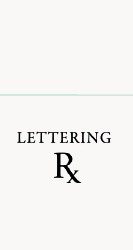Stephanie Fishwick — Part II
Photograph by Elizabeth Messina
Thank you everyone to the positive feedback on Stephanie’s Part I interview, so happy to hear that you love her as much as we do! Stephanie did not hold back and I think you will find a ton of supplies and resources to look into after this interview. Also, a Happy Birthday to Stephanie is in order! Thank you Stephanie so much for making this such an amazing interview!
What are some of your favorite supplies?
My favorite things now are my ruling pens and folded pen. I’m also loving a folded pen I made from a coke can. When doing pointed pen work, my favorite every-day supplies are the hourglass adjustable oblique pen holder with a Nikko G nib. The Tachikawa T-36 is my favorite straight holder. For brush lettering I use the Cotman 222 series brushes by Windsor & Newton, Rekab No. 314 Kolinsky Sable Brushes and various synthetic brushes with tiny tips. I love my bamboo brush. I use carbon-based black ink, pigmented ink for a luminous or crystalline look, and acrylic ink for color. Higgins Eternal is my favorite carbon-based ink. It’s great and very affordable and I go through black ink fast. I also love Moon Palace sumi ink. For acrylic work I am a big fan of Dr. Ph. Martins series. (Acrylic inks require more cleaning and attention to the nib, but I prefer them to gouache). I use a lot of watercolor in my work, as well. Favorite papers: hot press and cold press watercolor papers. For large final pieces I use 110 lb – 300 lb mould-made, pH neutral, papers that are 100% cotton. Some favorite brands are Fabriano, Aquarelle, Ingres and Arches. For things I will scan, as opposed to an original art piece, I like Canson Market Pro Layout or even 100% cotton resume paper that I find at an office supply store. The lower-end pads of Canson and Strathmore, cold-press 140lb paper for example, are great for my drafts or quick work.
Can you go a little into your process of how you work on a project?
My process is hard to describe. I had to ask my husband about his observations before I could put this into words! I write down ideas in lists a lot and mull things over in my head for a bit before drawing it out. I may spend two days thinking about an idea and then I’ll put it to paper in lots of different versions. Other times I’ll just want to do calligraphy without any goal in mind and come up with something I love. Many days I will sketch or write like 30 pages worth of quotes or words before I come up with the final piece that I like…or nothing good at all. Sometimes after writing a word 50 times I realize one of the first ones was my favorite. For client work I am way more scheduled and organized.
Photography by Corbin Gurkin
Any tips for newbies on how to develop their own style?
I would encourage newbies to learn Copperplate from a teacher who has mastered the form. Acquire the best materials, and set up a designated calligraphy work space for yourself. Everyone’s hand is different, so literally going with your flow will produce unique results. I think that any new styles work best when the architecture of the letters come from traditional copperplate.
Any recommendations of books or classes for lettering enthusiasts to further their studies?
Mastering Copperplate Calligraphy by Eleanor Winters, Calligraphy in the Copperplate Style by Herb Kaufman, Foundations of Calligraphy by Sheila Waters, Scripts: Elegant Lettering from Design’s Golden Age by Steven Heller and Louise Fili, Zanerian.com: Dr. Joe Vitolo’s site chock full of tutorials, lessons, guides, you-name-it, he’s got it covered. IAMPETH: The go-to for all-things pointed pen, and classes in your area. Check out your local guild for information on local classes.
Photograph by Erich McVey
Any advice on what ‘not’ to do?
Don’t doubt yourself as a lettering artist. I find it difficult to do that in the face of the internet, and basic human nature for comparison. I would say don’t get complacent in your study of fine art, its history, and your personal inspirations as you create your own style. This is something I am constantly working at.
Name one random talent you have that people may not know?
For a long time I was big into making artist books! I don’t make them anymore, but it fits well with calligraphy so maybe I will bring that back someday!









